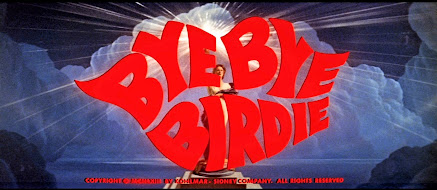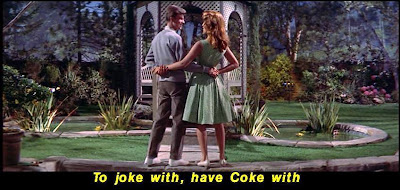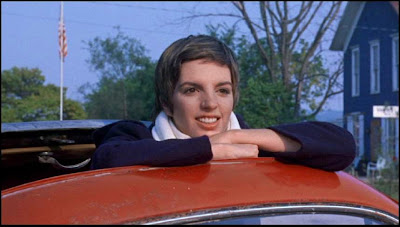Sure, Bye Bye Birdie is a bright, lively, tuneful, only intermittently funny satire of teenage pop culture in the '60s. But as far as I’m concerned, Bye Bye Birdie has two huge assets (I know what you’re thinking…and you should be ashamed of yourself!) which make it one of my all-time favorite movie musicals. Those assets: the unstoppable star-quality of Ann-Margret, and the snappy musical staging and choreography by Onna White.
 |
| Ann-Margret as Kim McAfee |
 |
| Bobby Rydell as Hugo Peabody |
 |
| Dick Van Dyke & Janet Leigh / Albert Peterson & Rose DeLeon |
 |
| Mary LaRoche & Paul Lynde / Doris and Harry McAfee |
 |
| Jesse Pearson as Conrad Birdie |
Adapted from the 1960 Tony Award-winning Broadway musical, Bye Bye Birdie pokes gentle fun at
America’s burgeoning youth culture by spoofing the real-life pandemonium
surrounding hip-swiveling pop star Elvis Presley being drafted into the army in
1958. Standing in for Elvis in the musical is the fictitious rocker Conrad Birdie (Jesse Pearson): a beer-swilling, ill-mannered, libidinous hillbilly who wreaks havoc on prototypical
Midwestern small town, Sweet Apple, Ohio when he arrives to bestow a symbolic
coast-to-coast televised goodbye kiss on an adoring female fan before being
shipped overseas.
Cue the generation-gap complications and small-town vs.
show-biz culture clash hijinks. None of which, I might add, should anyone having
even the most cursory familiarity with '60s-era sitcoms should have trouble
staying one step ahead of. Bye Bye Birdie,
when it’s either singing or dancing, is the most engaging and sprightliest of
musicals, full of fun and as eager to please as a puppy. In its quieter
moments—scratch that, there are no
quieter moments—in its non-musical moments, Bye
Bye Birdie's amusing, if not particularly funny, screenplay feels a tad
labored and more than a little creaky.Rooted in a kind of broad, over-emphatic acting style of most sixties sitcoms (a style that struck me as riotous when I was nine, a good deal less so now) and over-reliant on moldy, near-vaudevillian comedic shtick of the sort that considers silly names (Hugo Peabody) and wacky plot contrivances (that deadly speed-up pill subplot) the height of comedic brilliance; Bye Bye Birdie stays afloat chiefly through its simple desire to entertain and because of the buoyant charm of its talented and energetic cast.
 |
| The Sweet Apple chapter of The Conrad Birdie Fan Club (fronted by Ann-Margret and Trudi Ames) pledge undying allegiance. |
The film version of Bye Bye Birdie was significantly (and, as per the voiced consensus of Dick Van Dyke, Janet Leigh, Paul Lynde, and Maureen Stapleton, controversially) retooled from the stage production. Primarily a middle-aged romance (Albert & Rosie) against a satirically rendered teen-culture backdrop, the Broadway production was nominated for eight Tonys, winning four: Best Musical, Best Director, Best Choreography, and Best Actor (Van Dyke). By the time it reached the screen, what was essentially a Dick Van Dyke showcase was fashioned by director George Sidney into a $6 million valentine to vivacious protégé Ann-Margret.
This was Ann-Margret's third film (she made her debut in Pocketful of Miracles, and assumed the Vivian Blaine role in the 1962 remake of State Fair), but thanks to Sidney's loving attention and her heretofore peripheral character being thrust to the film's center, Bye Bye Birdie is the movie most people credit with making her a star.
What began life as an anti-rock & roll musical fashioned to reflect the middle-age mentality of adult Broadway audiences reeling from rock & roll upstarts like Elvis stealing the Sinatra crown, arrived on the screen as a youth-centric glorification of teenybopper culture that effectively allocated once-prominent adult plotlines and relationships to the sidelines to make way for the fresh vitality of its young cast members (aka Ann-Margret). With Dick Van Dyke and Paul Lynde the only carry-overs from the Broadway show, numerous songs jettisoned and plotlines abandoned or reworked; Bye Bye Birdie became the ironic embodiment of all that the Broadway play had spoofed. Bye Bye Birdie, hello to the first multimillion-dollar teenage musical!
WHAT I LOVE ABOUT THIS FILM
One look at Bye Bye
Birdie and it’s easy to see why it has become one of the most imitated and
referenced movie musicals since The
Wizard of Oz. Each number in the bouncy Charles Strouse / Lee Adams score
is given almost cartoonishly vibrant life in increasingly clever and dazzlingly
cinematic ways. So many large-scale musicals fall into the trap of thinking
that mere size and expense is enough to make a film fun and energetic; Bye Bye Birdie is that rare example of a
musical whose scale perfectly fits its subject, and whose accumulated talents (dancers,
singers, cinematography, color, choreography, staging, and minor special effects) all remain on the same creative page. Every number
throughout is infused with a lighthearted wit and silliness that remains true
to the escapist tone of the entire enterprise. The effective musical film is almost a lost art, but Bye Bye Birdie
is a glowing example of the genre done right. Small wonder that musicals like Grease and Hairspray, and entertainments as diverse as music videos, TV’s Mad Men, and Disney’s High School Musical franchise, have all
owed a debt to Bye Bye Birdie.
The combined talents of director George Sidney (Pal Joey, Annie Get Your Gun) and choreographer Onna White (The Music Man, Oliver!) result in a movie whose clever, eye-popping musical sequences are a great deal of silly fun and still have the power to delight and captivate after all these years."The Telephone Hour (Going Steady)" predates the look of MTV music videos; "Put on a Happy Face" makes imaginative use of cute, if primitive special effects; and "A Lot of Livin' to Do" is a powerhouse production number of unparalleled energy and witty choreography.
 |
| Oscar and Tony Award-winner Maureen Stapleton makes her musical debut in Bye Bye Birdie as Mae Peterson, Albert's dominating mother. |
PERFORMANCES
In her 1982 book 5001 Nights
at the Movies, fave film critic Pauline Kael wrote the following about Ann-Margret in Bye Bye Birdie...and I couldn't have said it
any better: “Ann-Margret, playing a
brassy 16-year-old with a hyperactive rear end, takes over the picture; slick, enameled,
and appalling as she is, she’s an undeniable presence.”
OK, I might have left out “appalling.”
Beyond that, Kael pretty much nails Ann-Margret’s appeal
for me in this film and why any director would have been a fool not to have
kept the camera trained on her every second. She's a dynamo! Members of the film’s cast may
have felt slighted, and fans of the stage show may cry foul, but in my book, if Bye Bye Birdie is remembered at all
today, it’s due in large part to Ann-Margret. The material is just too ordinary as it is. She is camp, a little over the
top, and perhaps artificial as hell, but she is blessed with that indefinable something that makes it near-impossible for you to watch anyone else when she's on the screen. She’s a star.
 |
| Real-life teen idol Bobby Rydell makes his film debut as Ann-Margret's love interest |
THE STUFF OF FANTASY
There aren't many lines across which the life experiences of
gays and straights of my generation intersect, but one thing that many males (and
a good many females) my age have in common—regardless of sexual orientation—is
the memory of their first time seeing Ann-Margret singing the film’s title
song. Whether we saw it on the big screen in full color or in black and white
on our TV sets, like the Moon Landing, few of us ever forgot or recovered from that image. Wow!
The fifties had Marilyn Monroe standing over that subway grate, but we children of the sixties had Ann-Margret on that treadmill. A sequence so obviously tame, perhaps it's a testament to our nation's level of sexual repression at the time that Ann-Margret, in those few short minutes at the start and end of the film, made men, women, children, straights, gays, lesbians, and adolescents of all stripes fall in love/lust with her.
The first time I saw Bye Bye Birdie was in black & white on late-night TV. I remember being just thunderstruck (I'm positive my jaw dropped open). I'd never seen anything like her! Advancing and retreating against that endless void, wind machine a-blowing...Ann-Margret was nothing less than a celluloid Venus emergent.
 |
| The dancer assuming the puppy hands pose with Bobby Rydell here is Lorene Yarnell, who found fame in the '70s as half of the popular mime duo, Shields and Yarnell. |
THE STUFF OF DREAMS
As I've stated, Bye Bye Birdie is one of my favorite movie musicals, but primarily due to its songs, musical sequences, and the rapturous presence of Ann-Margret. I have no complaint with anyone in the cast except to say that they're sorely ill-served by the weak script and they're all goners when it comes to having to share any scenes with Miss You-Know-Who. Predictably, I'm finding that the older I get the more certain aspects of the film seem to strike me as charmingly camp or comically dated. Some of these things are fun: the middle-class suburban milieu, the fashions, all those rotary phones. Other things less so: the all-white cast, that Shriner's Ballet when it starts to get out of hand (the 2009 Broadway revival removed the number entirely claiming, in the words of its star Gina Gershon, "It seemed a little too gang rape-y").
So whether enjoyed as camp, escapism, or an idealized journey to a past that never existed, Bye Bye Birdie is, at 50-years, still the most fun-filled musical around. And best of all, it has Ann-Margret!
 |
| This great caricature is the work of Pete Emslie |
Copyright © Ken Anderson 2009 - 2013















































